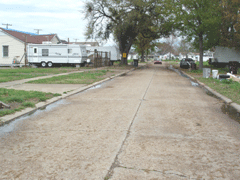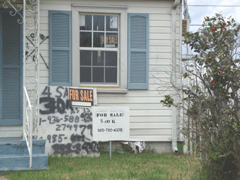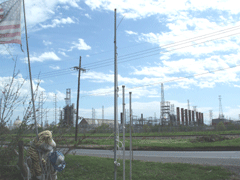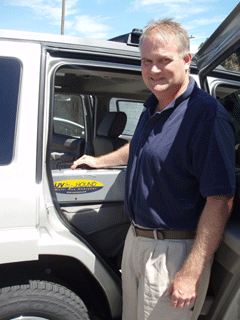Chalmette’s Troubled Vista
Air Date: Week of August 3, 2007

(Photo: Ingrid Lobet)
Two years after Hurricanes Katrina and Rita, the community of Chalmette Vista, outside New Orleans, is struggling to get back on its feet. The Gulf Coast community sits next door to an oil refinery complex and is not only up against problems with levees, land and housing, but also acrid smells and air pollution. Living on Earth’s Ingrid Lobet reports.
Transcript
CURWOOD: It’s Living on Earth. I’m Steve Curwood. As part of our continuing coverage of the rebuilding of New Orleans, we visit the Chalmette Vista neighborhood of St. Bernard Parish. Chalmette Vista is right next to a major oil refinery complex and even before Hurricanes Katrina and Rita flooded out virtually every home, residents were as used to acrid odors and washing the refinery soot off their cars as they were to eating crawfish. Today, about a third of the residents have returned and they find themselves wondering if Chalmette Vista can become a viable community. Living on Earth’s Ingrid Lobet reports.
LOBET: In Chalmette Vista when you look up, you see the pipelines and stacks of the Exxon Mobil refinery. Look down and the neighborhood stretches out like a sick patient, two years after the twin visitations of Katrina and Rita. The floods swept away everything Ray Clement had except his wife’s ashes. While he talks, a small ball of orange fire appears at one the refinery stacks and extinguishes in black smoke. The Gulf breeze carries an acrid smell.
CLEMENTS: Crude oil, that is what you get a lot of, that crude oil smell. Mostly that rotten egg smell and ammonia, smell like ammonia, it takes your breath away.
LOBET: This was one of the most populous refinery communities in the country. But Clement and other says it was never easy to live here. Often you had to close your windows to the smells, even in the heat of summer. And sometimes that wasn’t enough.
CLEMENTS: You couldn’t stay in the house. You’d go take a ride, a walk in the Quarter or something, but there’s no place to go here no more.
LOBET: No place to go because so many businesses are closed now, their patrons scattered in a St. Bernard diaspora. A few remain, and perhaps the community’s best-known resident, Ken Ford. Ford and his wife raised two children here and he repaired airplanes for the National Guard. But the reason for his reputation is that he kept records on refinery emissions for four decades and tried to organize his neighbors to agitate for cleaner air, but that community memory bank is gone.
FORD: My neighbor Frank Dear, he’s gone he ain’t coming back. He knew what was going on. Across the street he knew what was going on, 54 years here. George Blester and Lou Blester they both died. People aren’t coming back. The people I said earlier, that know what’s going on, aren’t coming back.

Trailers visible in Chalmette Vista neighborhood where every single house was destroyed. Some of the houses show recent repairs. (Photo: Ingrid Lobet)
LOBET: Ford gestures at the FEMA trailers that still edge out of driveways here. Empty houses once worth 110 thousand dollars, now offer themselves up for 40 thousand as sellers pray for a buyer, a miracle. He shows a visitor past his gutted-out house to where a small frame building lists sideways.
[SOUNDS OF FOOTSTEPS AND DOOR OPENS]
FORD: Don’t break your neck in here. See all this is ruined, everything’s ruined.
LOBET: This back building was Ford’s war room, buzzing with scanners, a ham radio, and full of color-coded binders, thick with minutes from public meetings and air monitor read-outs. Little remains, just the smell of mildew and a water-worn photograph signed by Erin Brockovich.
FORD: I said what I am supposed to do Erin? And she said, “Never give up. Erin, Lot’s of love.” So I kept it.
LOBET: Sometimes, Ford says, he feels like that Indian in the 1960s public service announcement, the one with no words, where the guy gazes at litter along the highway and you see a tear on his cheek.
FORD: Now I feel like I’m a white man looking at my environment, looking at my neighborhood getting destroyed and can’t do a damn thing about it but look out there and cry.

Damaged house up for sale in Chalmette. (Photo: Ingrid Lobet)
LOBET: Chalmette residents were mostly white; old time families often had Italian, Irish and Spanish Canary Island backgrounds. Over the years Ford did attract a few supporters, the Tulane University Environmental Law Clinic. And an organizer from Cajun country, the founder of a group called the Bucket Brigade, Anne Rolfes.
[DOOR OPENS, DOG BARKING]
ROLFES: Hello how you doin’? My name is Anne, I’m here with the Bucket Brigade.
LOBET: Like Ken Ford, Anne Rolfes refused to give up on Chalmette Vista after hurricane Katrina. On this day she’s trying to find out who, among those left here, would be willing to write down when they see or smell something in the air. Louise Serpas steps past her barking dog and says she’d be glad to.

A knapsack full of letters from community members to Exxon Mobile expressing their concerns about air pollution from the company’s nearby refinery. (Photo: Ingrid Lobet)
ROLFES: If you see things like a flare, or smoke
SERPAS: We do, right there look, at night.
ROLFES: See okay, alright so you know what would be really great--
SERPAS: Sometime it’s black but most of the time it’s fire!
ROLFES: Well you know and that’s exactly what we would like you to do, because…
LOBET: Perhaps because the neighborhood is so quiet now, Ms. Serpas isn’t eager to see a visitor leave, even if her dogs are.
SERPAS: If it wouldn’t be for the dogs I’d invite you all inside. Bye baby.
LOBET: It may be too early to say whether the flooding dealt a mortal blow to this community. A few pre-Katrina neighborhood anchors have returned, and lightened people’s hearts: especially Rocky and Carlo’s Restaurant where a plate rich with olives is still called a “wop salad.” But it’s clear that a place that was hardscrabble before, is even harder now and part of the reason is Americans’ demand for gasoline. Ken Ford says a little refinery once built by the Standard Fruit Company to fuel its Central American banana boats has swelled to many times that size.
FORD: Where today we have a refinery close to 200 thousand barrels today. Besides all the chemicals they make it’s not just the refinery, it’s the manufacturing plant. They make benzene.
LOBET: American refineries have been running full bore, even before the 2005 hurricanes that took several offline, including Chalmette. To meet growing demand, refinery owners around the country have expanded capacity at existing plants rather than build new ones, in part because getting a permit for a new refinery is so difficult. Howard Feldman is with the American Petroleum Institute.
FELDMAN: Everybody wants the fuels, and nobody wants the refinery nearby. There are tradeoffs obviously.
LOBET: With plants running at capacity, equipment failures and accidental releases of pollutants are more common. Two years ago a federal judge in New Orleans ruled Chalmette refinery had released illegal amounts of benzene into the air more than 1200 times in the two preceding years.
And documents obtained by this program show Chalmette Refinery frequently asks the state of Louisiana for permission to emit extra pollutants, such as sulfur dioxide, and those requests are routinely granted. Other documents obtained show that well after Hurricanes Katrina and Rita, Chalmette refinery was still burning off hundreds of thousands of pounds of acidic sulfur gas in its flares. In one incident that went on for days, the company was granted a legal exception, so the emissions cease to appear in the record, even though they continued to pour into the air.
Jane LaCour, a scientist and air enforcement official with the Louisiana Department of Environmental Quality explains how that’s possible.
LACOUR: Once a company is issued a variance, or permit, then those emissions are authorized, and it’s no longer an unauthorized release.

The Chalmette refinery and adjoining facilities.
(Photo: Ingrid Lobet)
LACOUR: I believe you’re right, I don’t think any penalties have been issued since then.
LOBET: ExxonMobil declined numerous requests for an interview but via email said the company is investing 200 million dollars in environmental improvements at Chamette. In the view of the Refinery Reform Campaign, an activist group, this situation isn't unique to Chalmette. Denny Larson is national coordinator.
LARSON: The levels of enforcement and oversight and monitoring and the state and local agencies, has almost gone to nil. I would argue, for fear that they would be caught in the claim that they're causing high gas prices, they're causing a shortage of gasoline supply. And the people who are coming back to try rebuild their lives in the shadow of refineries are suffering doubly because of that.
LOBET: There is another major trend Chalmette witnesses from its front row, Gulf Coast seats. From just across the waters to the south, come tankers filled with heavier, dirtier crude from Venezuela. Chalmette refinery uses the heavy crude, and so do more and more others. When it comes to oil, not all is created equal. You’ve heard of light, sweet crude? The “sweet” means less sulfur. Sour crude contains more sulfur, and sulfur has to be removed. “Light” means oil that’s thinner, easier to refine. Analytical chemist, Alex Cuclis worked at a Shell refinery for 15 years and now manages research at the Houston Advanced Research Center.
CUCLIS: All the crude oil sources are getting heavier, which means there’s more asphalt-like material available.
LOBET: Heavier crudes often require extra machinery. Refiners are increasingly installing a special kind of machine called a coker to deal with the grainy remains of heavier crudes.
CUCLIS: Cokers can be as tall as 100 feet tall and 25 feet in diameter drums, that are used to process material that is the bottom of the barrel material in an oil refinery. They heat it up to 900 degrees Fahrenheit in a furnace and it will vaporize and some will go on out and be recovered as gasoline and other light products. The remainder will coke up and about 30% of it becomes a solid coke. These drums will fill up, anywhere from say 8 to 18 hours, and once they’re filled, they need to be opened up and the coke is dropped out the bottom.
LOBET: Ken Ford says often when the air in his neighborhood is sharp with some smell and he calls the refinery, he’s told they’re having problems with the coker.
FORD: The times I’ve called, most of the time it’s the coker #2, coker #2, coker #2.
LOBET: Again, activist Denny Larson with the Refinery Reform Campaign.
LARSON: When you bring in a dirty sour crude, that means more pollution for the neighborhoods, it also means not just routine pollution because you got to pull that sour gas and things out, but you tend to get more upsets, malfunctions, flare offs, fires and explosions. So it's not only dirty to the enviornment, it's dangerous to the neighbors.
LOBET: But refiners don't agree. Cindy Schild of the American Petroleum Institute says while it's true refiners are taking in more sour and heavy crude, that doesn't necessarily translate to more emissions.
SCHILD: Every unit that is added at a refinery is going to have to meet environmental permitting requirements so that would be any federal, state or local standard. If you’re talking about adding more volume at refineries, it’s possible that the amount of emissions could increase somewhere. Lust like anything else, if you’re making more of something. But you got to keep in mind that nothing is going to go through that is going to violate any clean air standards or other environmental regulations.
LOBET: Indeed, this region of Louisiana meets all federal air quality standards. But these guidelines say nothing about individual neighborhoods or hotspots. And several experts told Living on Earth something surprising. They say new data shows these proliferating cokers are giving off huge amounts of pollutants—amounts that could actually equal or surpass the emissions of the entire refinery for VOCs, or volatile organic compounds. Again Alex Cuclis:
CUCLIS: That’s really what is a big controversy going on right now in EPA, and elsewhere. In this recent report in Canada, they found that the emissions from these coke drums were substantial. In fact, two and a half times what the refinery had reported for the entire refinery that year. For VOCs. And they also found benzene levels that were the highest source of benzene, aside from storage tanks, in the refinery as well.
LOBET: That bears reiteration. VOCs have a strong role in air pollution, and many are carcinogenic or harmful to the liver and kidneys. Regulators haven’t known that cokers release any VOCs, and now it turns out they may release as much or more as the entire facilities of which they’re a part.
But that’s not all. For years Chalmette and other U.S. refineries have estimated their total emissions. But data from Europe and Canada, shows refineries are very likely giving off much higher emissions than previously thought.
CUCLIS: There have been over 30 studies done at different refineries and in the best case, the refineries are at least three times higher than they are reporting, more typically they’re 10 times higher, and sometimes 30 times higher or more than what they report.
LOBET: In fact privately, government officials say they’ve been looking in the wrong places for pollutants. This massive undercounting of emissions has skewed regulatory efforts. What’s making these extraordinary figures come to light is technology.
Using infrared and ultraviolet techniques, some first developed for the military, you can now point a beam of light at say, a boat’s smokestack, a pipe, or a tank full of volatile liquid, and an invisible plume becomes visible.
GAMILES: See right now do you not smell something?
LOBET: I’m sitting in an SUV outside a refinery in Los Angeles with Don Gamiles. Gamiles began his career in physics and nuclear engineering at Oak Ridge National Lab. His interest in monitoring put him on the Iraq weapons inspection team before the second Iraq war. But what he’s riveted by are the possibilities offered by this monitoring technology.

Don Gamiles with a real-time air monitor that he developed himself. (Photo: Ingrid Lobet)
GAMILES: See now we are getting toluene, so hydrocarbons are showing up along with toluene.
LOBET: He’s showing me a device he’s developed that you can put in the back seat of a vehicle. It continuously samples air through a hose stuck out the window. The air is fed into a box where it passes through a beam of light.
GAMILES: Ultraviolet light very close to what you would with a tanning bed bulb and gases in there will absorb different wavelengths of light. And different gases will actually absorb different wavelengths. So each gas in essence creates its own fingerprint. And you can see there’s absorption peaks there, absorption peaks there, and absorption peaks right in the middle. The one in the middle that’s benzene, that’s the fingerprint for benzene, are these four peaks.
LOBET: With a laptop screen set on the dashboard, as we drive, the machine generates a constantly-updating, real-time readout for 9 gases he’s chosen—today it’s benzene, butadiene, xylene, toluene, unburned gasoline, ammonia, sulfur dioxide, nitric oxide and ozone. It cannot measure particles.
GAMILES: The beauty of all of this stuff is that as we have been sitting here and this has been taking air into the system, how much has it cost us? Nothing.
LOBET: Nothing beyond the purchase cost of 25 thousand dollars for this, or 65 thousands for some of the infrared systems. But with traditional canister sampling, if you gathered one single sample a day for a year, and sent it off to a lab for analysis, you could easily spend 150 thousand dollars and have much less of a picture.
Refinery chemists, state regulators and environmentalists are increasingly using these types of technology to find hotspots that have long gone undetected. Gamiles says some refiners are using it to prove that not all the complaints they receive are really their fault. He cites one he’s been working with.
GAMILES: They were able to that show 40% of the problem was not them.
LOBET: Industry was skeptical of the technology at first, arguing it was unreliable. But Howard Feldman of the American Petroleum Institute says current systems measure up.
FELDMAN: In general we support having the most accurate emissions numbers, and we do believe these technologies work. And if that’s where it leads to and if there are facilities that need to be tightened, I think that the consensus of the industry is that people should operate within their permitted limits.
LOBET: Environmental advocates in Chalmette and elsewhere desperately want refineries to use the new continuous monitors and mobile cameras. Gamiles says they’re driving the adoption of this technology.
GAMILES: They were interested and they saw the need. They are the ones, more than the EPA, who have pushed this type of technology and is bringing it to the forefront in the U.S. Without them, there would be no market whatsoever.
LOBET: And it’s no mystery why. Real time data on specific gases crossing the refinery fence line, potentially shifts power into the hands of the community. One ConocoPhilips refinery in northern California has taken this step. So far, Chalmette has declined. Resident Ken Ford says he hopes he lives long enough to see accurate measurement of the air people are breathing.
FORD: I’m not a religious fanatic, and I don’t mean to sound like one, but sometimes I really believe, you know everybody has a purpose, and sometimes I think I got a purpose fighting this stuff. But my body is wearing out, I’m getting old. If somebody would have done what I’m doing as hard as I’m doing, with me 20 years ago, I may have my left lung right now.
For Living On Earth, I’m Ingrid Lobet.
[MUSIC: Branford Marsalis Quartet “Autumn Lamp” Romare Bearden Revealed (Marsalis Music - 2003)]
Links
Living on Earth wants to hear from you!
Living on Earth
62 Calef Highway, Suite 212
Lee, NH 03861
Telephone: 617-287-4121
E-mail: comments@loe.org
Newsletter [Click here]
Donate to Living on Earth!
Living on Earth is an independent media program and relies entirely on contributions from listeners and institutions supporting public service. Please donate now to preserve an independent environmental voice.
NewsletterLiving on Earth offers a weekly delivery of the show's rundown to your mailbox. Sign up for our newsletter today!
 Sailors For The Sea: Be the change you want to sea.
Sailors For The Sea: Be the change you want to sea.
 The Grantham Foundation for the Protection of the Environment: Committed to protecting and improving the health of the global environment.
The Grantham Foundation for the Protection of the Environment: Committed to protecting and improving the health of the global environment.
 Contribute to Living on Earth and receive, as our gift to you, an archival print of one of Mark Seth Lender's extraordinary wildlife photographs. Follow the link to see Mark's current collection of photographs.
Contribute to Living on Earth and receive, as our gift to you, an archival print of one of Mark Seth Lender's extraordinary wildlife photographs. Follow the link to see Mark's current collection of photographs.
 Buy a signed copy of Mark Seth Lender's book Smeagull the Seagull & support Living on Earth
Buy a signed copy of Mark Seth Lender's book Smeagull the Seagull & support Living on Earth

